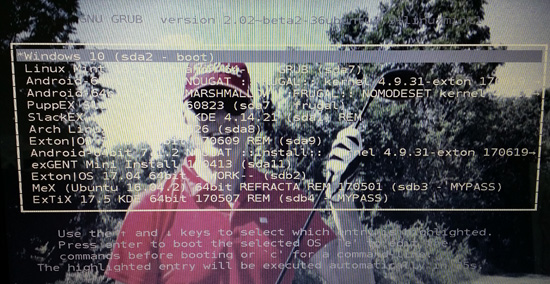

- #Grub2 windows 10 64 install#
- #Grub2 windows 10 64 update#
- #Grub2 windows 10 64 32 bit#
- #Grub2 windows 10 64 upgrade#
- #Grub2 windows 10 64 windows 7#
#Grub2 windows 10 64 update#
just sayin :)ħ to update it's dang self after a fresh DVD installation. Both Mint & Debian fetched heaps of updates effortlessly, only requiring me to provide superuser credentials for execution. I had to go thru hoops just to get Windowsħ to update it's dang self after a fresh DVD installation. If you're editing an existing config file, make a backup I used Grub-Customizer to add the new grub config. If that file is already an entry for a working config, change 40 to another number that's not already used in /etc/grub.d/ lower numbers are loaded first. Same goes for their respective update facilities. You can add a custom entry to GRUB2 by editing /etc/grub.d/40custom. Seems a little crappy that a paid commercial OS is so much more finicky than a freeware OS - Linux didn't give a hoot about the existence of a Windows EFI partition. The latter didn't actually take up any add'l HDD space - instead it cannibalized its own partition a tad to facilitate this.
#Grub2 windows 10 64 upgrade#
Perform another update-grub for all OSes to be available at boot-time.Ĭonclusion is that the issue seems to have been twofold: First, the Windows 10 upgrade process didn't like the presence of the (2) Linux EFI partitions (even though they were totally empty) Second, the upgrade seems to need add'l disk space to create the Unfortunately, since Windows had re-ordered the partitioning scheme during the upgrade, I had to reinstall grub, boot to Windows 10 again, and then Once Windows 10 seemed to be stable, I UEFI booted Debian and recreated my Linux EFI partitions. Windows 10 also lopped off about 400MB from it's own partition and created a small "Recovery" partition immediatelyįollowing.

#Grub2 windows 10 64 windows 7#
I noticed post-mortem that the upgrade process removed the 128MB BitLocker partition Windows 7 had created during installation. however THIS TIME, the Windows 10 upgrade process didn't simply flash me a 0% circle it stayed on the progress circle and completed the upgrade. Popped in my Windows 10 圆4 DVD and the process kicked off just like countless previous failed attempts. I was able to simply re-create a FAT32 partition for Debian which restored GRUB2 and a normal boot process.įeeling confident that I could easily restore my Linuxes, I removed both of their FAT32 EFI partitions using DISKPART. Options in my system BIOS allowed for choosing a partition known as a boot device (booting to LiveCD also worked). I experimented with simply removing the EFI partition for Debian which whacked GRUB2 from loading. None of these resolved the issue.Īs I mentioned in the original post, I have Windows 7 SP1 圆4 (EFI / GPT), Linux Mint v18 圆4 (EFI), and Debian Linux v8.5 圆4 (EFI). Then, boot the Ubuntu live usb or dvd and in the boot menu (F9 key) check for the USB Drive+UEFI to boot the UEFI Ubuntu image. I followed advice I had read to disconnect all HDDs except for the boot drive, remove antivirus (Sophos in my case),ĭisable SecureBOOT in BIOS, disk error checking, Disk Cleanup (CCleaner also), and lastly a clean boot via MSCONFIG. To recap, I originally had a total of (4) HDDs with #1 for OSes, #2 files from my previous system, and #s 3 & 4 new in a RAID-1 mirror. Runs open source GNU Grub 2.02 code.As I suspected, the trouble with getting Windows 10 to successfully upgrade from Windows 7 was the presence of (2) add'l EFI partitions on the same physical drive.Grub customization is done from Windows - Configuration in Linux is not required.Safely multiboot Windows, Remix, Android, Ubuntu, Debian, Suse, Fedora, Mint and more.Supports extremely large (over 4 TB) disks and partitions.Works with both GPT and MBR disks - up to 128 primary partitions per drive.Can search for and boot a partition by it''s label.Works with all filesystems including Mac hfs and Btrfs.Grub boot messages and help can be displayed in 31 major languages worldwide.Preview and customize the 9 included themes.Lets you set your EFI firmware boot order from within Windows.Simple Windows GUI easily sets up Grub2Win in seconds.Requires just one directory on the Windows C: drive, about 18 MB disk space.
#Grub2 windows 10 64 32 bit#
#Grub2 windows 10 64 install#
Using the simple Windows GUI and instructions you can install Grub2Win quickly and safely. Grub2Win provides dual boot options for Windows and Linux from GPT or MBR disks.


 0 kommentar(er)
0 kommentar(er)
